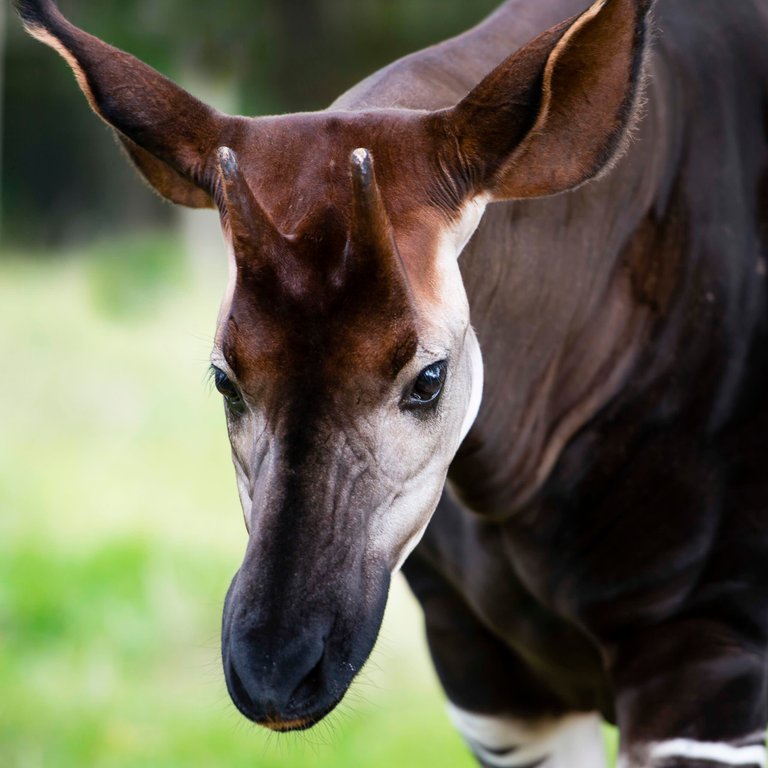Hola amig@s de Hive, en esta ocasión les comentaré acerca de una de las especies del Reino animal menos conocidas y que hasta hace poco tiempo se pensaba que estaba extinta, me refiero al Okapi.
Hello friends of Hive, this time I will tell you about one of the least known species of the animal kingdom and that until recently was thought to be extinct, I am referring to the Okapi.

Foto tomada de Britannica/Photo taken from Britannica
Este curioso animal se ubica en las selvas del norte de la República Democrática del Congo entre los ríos Uele e Ituri y en las selvas de Aruwimi, en África Central, siempre en altitudes que superan los 500 metros.
This curious animal is found in the northern forests of the Democratic Republic of Congo between the Uele and Ituri rivers and in the forests of Aruwimi, in Central Africa, always at altitudes exceeding 500 meters.
El Okapi es un mamífero herbívoro (se alimenta generalmente de las hojas y tallos de una gran variedad de plantas, además de frutas), predominantemente solitario (rara vez vive en pareja o pequeños grupos). Es el animal que genéticamente se asemeja más a la jirafa.
Mide entre 1,90 y 2,20 metros de longitud, llega a alcanzar los 1,80 metros de altura y pesa de 200 a 300 kilogramos (la hembra es más grande y pesada que el macho).
Se caracteriza por tener un pelaje de color rojizo a marrón oscuro con rayas blancas horizontales en las piernas y la parte trasera (semejante a las cebras), sus orejas son grandes, sus patas y cuello cortos; el macho tiene dos cuernos pequeños cubiertos de piel en la frente. Posee una lengua de color azul oscuro a negra que llega a medir hasta 36 centímetros de largo (lo que le permite llevarse el alimento a la boca con mayor facilidad así como limpiarse las orejas, los párpados y espantar los insectos que estén a su alrededor). Sus sentido del olfato y el oído son los de mayor desarrollo. La esperanza de vida de este peculiar animal ronda los 30 años.
The Okapi is an herbivorous mammal (it generally feeds on the leaves and stems of a wide variety of plants, as well as fruits), predominantly solitary (it rarely lives in pairs or small groups). It is the animal that genetically most closely resembles the giraffe.
It measures between 1.90 and 2.20 meters in length, reaches a height of 1.80 meters and weighs between 200 and 300 kilograms (the female is larger and heavier than the male).
It is characterized by a reddish to dark brown coat with horizontal white stripes on the legs and back (similar to zebras), large ears, short legs and neck; the male has two small horns covered with skin on the forehead. It has a dark blue to black tongue that can measure up to 36 centimeters in length (which allows it to bring food to its mouth more easily, as well as to clean its ears, eyelids and scare away insects around it). Its sense of smell and hearing are the most developed. The life expectancy of this peculiar animal is around 30 years.

Foto tomada de Britannica/Photo taken from Britannica

Foto tomada de Rainforest Alliance/Photo taken from Rainforest Alliance
Debido al largo período de gestación de la hembra (entre 14 y 15 meses dando lugar al nacimiento de una única cría) y a la destrucción de sus hábitats, esta especie se encuentra en la actualidad en peligro de extinción, estimándose que su población oscila entre 10000 y 20000 individuos.
Due to the long gestation period of the female (between 14 and 15 months resulting in the birth of a single calf) and the destruction of their habitats, this species is currently in danger of extinction, with an estimated population of between 10,000 and 20,000 individuals.
Sin más...hasta la próxima!!!/Without further ado...until next time!!!.
Saludos desde Cuba/Greetings from Cuba.
Traducido por DeepL App/Traduced by DeepL App.
!CURATE BY
@biologistbrito
I think I had the privilege of seeing one of them in a zoo near my house. They are very curious. Thank you for sharing the information.😁🌷🧑🏻🎓
You are very fortunate to have the opportunity to see them. Regards
I've been reading your posts and I see that you put a lot of effort into providing information, but you don't get many votes, it's because whales rarely vote for posts like this. Do you want good votes? Do the same thing you do, but look for some bug or plant there and take some photos and upload information like you do. I promise you'll get a better reward. Hugs!
Thank you very much for your recommendation, I will keep it in mind. Regards